|
Taiwan is an exceptional area to investigate orogenic
processes because of very rapid rates of deformation and erosion,
as well as because of the wealth of data already available (geodynamic
setting, structure of the crust, recent deformation documented
by GPS and tectonic geomorphology…). The occurrence of
the Mw=7.6 Chichi earthquake in 1999 allows for investigating
how deformation resulting from earthquakes or from slower aseismic
processes during postseismic relaxation, or during the interseismic
period, contribute jointly to geological deformation over the
long term.
|
 Geodynamic
setting Geodynamic
setting
 Overview
of Taiwan geology Overview
of Taiwan geology
 Taiwan
and the "critical-wedge” model. Taiwan
and the "critical-wedge” model.
|
 How
is deformation partitioned across Taiwan? How
is deformation partitioned across Taiwan?
 The
1999 Chi-Chi earthquake: insights into the seismic cycle of West
Central Taiwan. The
1999 Chi-Chi earthquake: insights into the seismic cycle of West
Central Taiwan.
 References References
|
|
 Geodynamic
setting Geodynamic
setting
Taiwan is located at the boundary between
the Philippine Sea Plate to the East and the Eurasian Plate
to the West, with a convergence rate of ~ 80 mm/yr in a ~N118E
direction [Seno,
1977; Yu et al.,
1997] (figure1). This plate boundary
is rather complex since it comprises two subduction zones
of reverse polarities (figure 1). To the southwest, the ongoing
consumption of the oceanic crust of the South China Sea led
to the collision between the Chinese Continental Margin and
the Luzon Volcanic Arc ~ 6.5 Ma ago [e.g Lin
et al., 2003], that resulted
in the Taiwanese mountain range.
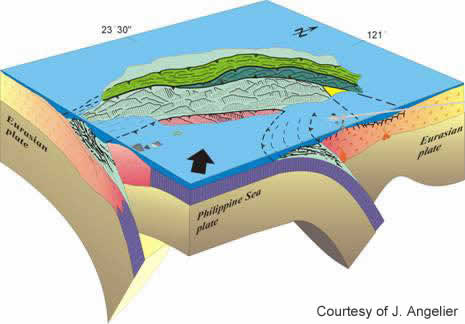
Figure 1: Geodynamic setting of the island
of Taiwan..
Because of the obliquity of the convergence,
the collision propagated to the south: the collision is mature
and fading to the north of the island while to the south, the
South China Sea is still subducting along the Manila Trench
(figures 1 and 2). Consequently, Taiwan is the perfect location
to better understand how the transition from subduction to
collision occurs (figure 2).
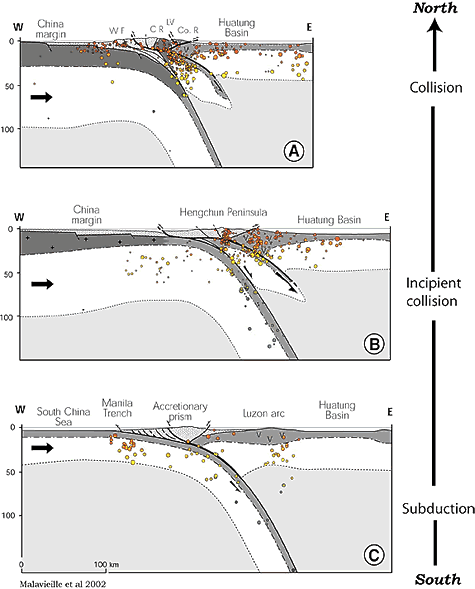
Figure 2: Transition from subduction of the
oceanic crust of the South China Sea beneath the Manila Trench
to the south (C), to mature collision between the Luzon volcanic
arc and the Chinese passive margin in Central Taiwan (A). Incipient
collision (B) occurs in the area of the Hengchun Peninsula
in southernmost Taiwan. Sketches are from [Malavieille
et al., 2002].
|
|
 Overall
geology of Taiwan Overall
geology of Taiwan
The geology of Taiwan may be described in terms
of different separated units (figure 3). From East to West:
- The Coastal Range which corresponds to the
accreted Luzon volcanic arc.
- The Longitudinal Valley which is considered
as the suture zone between the Luzon arc and the Chinese
continental margin.
- The Tananao Schists are comprised of the metamorphic
pre-Tertiary basement of the Eurasian passive margin. In
addition to the most recent metamorphic event, this unit
has also recorded past orogenic events.
- The Slate belt, composed of metamorphosed
and deformed sediments of the Chinese passive margin, with
from East to West:
- The Backbone Range, with mostly Miocene
to Eocene slates, corresponds to the area of highest
altitudes in the island.
- The Hsueshan Range, composed of mostly
Eocene and Oligocene sediments.
- The Western Foothills, at lower altitudes,
where syn-orogenic sediments of the foreland basin have been
accreted and deformed.
- The Coastal Plain which is part of the present
foreland basin of Taiwan.
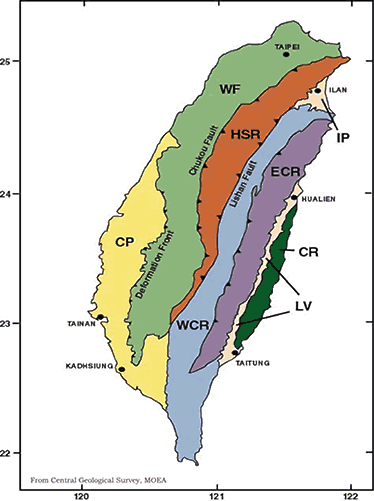
Figure 3: Major geological units of the Island
of Taiwan. CR: Coastal Range; LV: Longitudinal Valley; ECR:
East Central Range or Tananao Schist complex; WCR: West Central
Range or Backbone Range; HSR: Hsueshan Range; WF: Western Foothills;
CP: Coastal Plain. From Central Geological Survey of Taiwan-MOEA.
Although, the degree of metamorphism in the
Slate belt cannot be easily documented due to the poor mineralogy
of these rocks, it is thought that metamorphism increases from
west to east across the Taiwanese range. Within the TO, this
overall idea should be tested and refined by applying new methods
that have been recently developed to document maximum temperatures
encountered by slates during their metamorphic cycle.
|
|
 Taiwan
and the “critical-wedge” model. Taiwan
and the “critical-wedge” model.
Since the early 80’s and 90’s
[e.g. Barr and Dahlen,
1989; Barr
et al., 1991; Dahlen
and Barr, 1989; Dahlen
et al., 1984; Davis
et al., 1983; Suppe,
1981], Taiwan has been referred
to as the best example of the “critical wedge” type
mountain belt (figure 4).
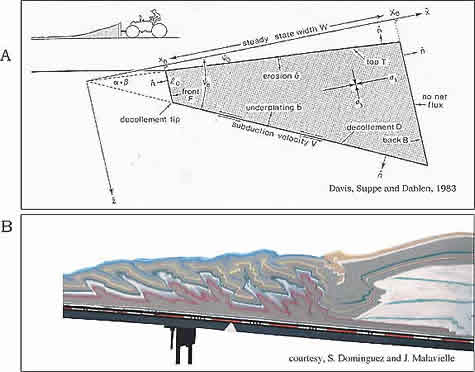
Figure 4: Critical wedge model of mountain
belts. A: Basics of such model as proposed by [Davis
et al., 1983]; it was refined later by [Barr
and Dahlen, 1989; Barr
et al., 1991; Dahlen
and Barr, 1989; Suppe,
1981] for Taiwan. Rocks get to be
deformed as sand would be in front of a rigid buttress overriding
a rigid footwall. B: Sand-box experiment image (courtesy
of J. Malavieille) illustrating this model.
In this model, a mountain belt is viewed as
a deforming wedge whose geometry reflects the balance between
frictional stresses at the bottom, and gravitational loads
induced by the topography. The mountain belt mostly grows by
frontal accretion and internal thickening. Since the wedge
has to maintain its equilibrium geometry, horizontal shortening
is expected to be distributed, such as the active faults that
accommodate this deformation. The model successfully accounts
for some aspects of the Taiwan orogen, such as its gross topography
and metamorphic structure; it had been tested, given the data
that were available by then. However, new constraints documenting
mountain-building processes in Taiwan had been published since,
and even more should result from the several TO investigations,
so that this model needs be re-evaluated and tested in light
of these new data.
|
|
 How
is deformation partitioned across Taiwan? How
is deformation partitioned across Taiwan?
Interseismic deformation (prior to
the 1999 ChiChi earthquake) recorded by GPS [Yu
et al., 1997] allows for gaining
some insights into how the ~ 80mm/yr of total convergence
are partitioned across the island (figure 5).
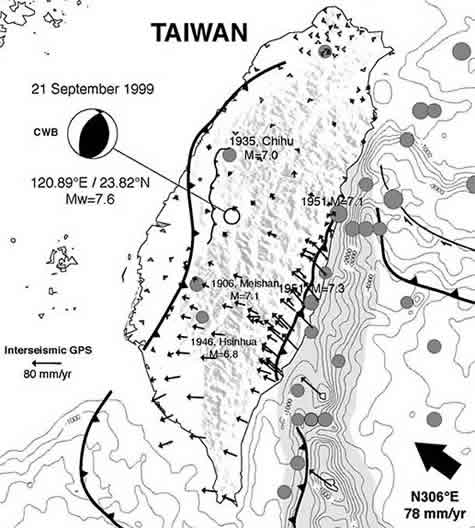
Figure 5: Interseismic deformation recorded
by GPS relatively to the Penghu Islands [Yu
et al., 1997]. The Chichi earthquake
surface rupture has also been reported. Figure from [Dominguez
et al., 2003].
Some portion of the shortening is consumed along the Longitudinal
Valley (figure 5); in addition to that, elastic dislocation modeling
of these GPS data [Dominguez
et al., 2003; Hsu et
al., 2003; Loevenbruck
et al., 2001] suggests that ~30 to 45 mm/yr would be
transferred to the Western Foothills through a sub-horizontal
decollement beneath the Central Range (figure 6).However, how
deformation in the interseismic period relates to long term slip
rates on faults is poorly understood because these slip rates
are only crudely estimated; it is unclear whether the shortening
rate is absorbed by a great number of small faults, resulting
in distributed deformation alike that predicted from critical
wedge models, or whether it is localized on a few large faults.
Within the TO, several projects aim at solving these important
issues. |
|
 The
1999 Chi-Chi earthquake: The
1999 Chi-Chi earthquake:
insights into the seismic cycle of West Central Taiwan.
The Mw=7.6 ChiChi earthquake in central
Taiwan that ruptured the Chelungpu fault over ~ 80 km in
September 1999 [Ma
et al., 1999] (figure 5) is to
date the most extensively documented earthquake. This allows
for investigating the different stages of the seismic cycle,
and to define their relative contribution to the long term
deformation and mountain building process.
The detail of the seismic slip history
and the co-seismic static slip has been constrained from
the inversion of seismic records [Ji
et al., 2001], field
[Lee et al.,
2001] and GPS measurements [Yu
et al., 2001] as well as SPOT
images [Dominguez
et al., 2003] (figure 6). These
studies show that coseismic slip was mainly confined to a
ramp dipping about 30°E at depths less than 5-7km, and
reached a maximum value over 12m at a very shallow depth
in the northern portion of the fault.
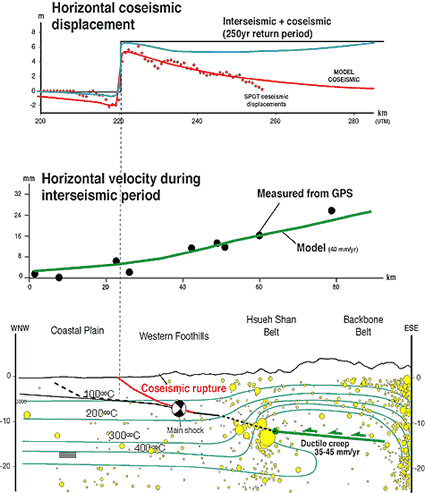
Figure 6: The ChiChi earthquake and the
seismic cycle in Central Taiwan. Top panel: Horizontal coseismic
displacements from SPOT images; interseismic and coseismic
displacements have been added together so as to calculate
a recurrence time for such earthquakes. Middle panel: GPS
displacements prior to the ChiChi earthquake and modeled
interseismic deformation assuming that 40 mm/yr are transferred
to the foothills through a sub-horizontal decollement beneath
the Central Range. Bottom panel: Geometry of the system and
how it compares to the thermal structure proposed by [Lin,
2000]. Figures from [Dominguez
et al., 2003].
Modeling of interseismic GPS data show that the Chelungpu fault
was previously locked to a depth where it would root to some
sub-horizontal decollement [Dominguez
et al., 2003; Hsu et al.,
2003; Loevenbruck
et al., 2001 ] (figure 6). If coseismic displacements
are compared to interseismic displacements, the recurrence interval
can be estimated to 150 to 250 years. This estimate assumes that
all the shortening stored during the interseismic period would
be taken up by coseismic deformation; also this assumes that
the shortening rate measured over the few years before the ChiChi
earthquake by GPS would be representative of the long term rate.
These assumptions might both be questioned and need further investigation. |
|
| References |
Barr,
T.D., and F.A. Dahlen, Brittle frictional mountain building 2.
Thermal structure and heat budget., Journal of Geophysical
Research, 94 (B4), 3923-3947, 1989. |
Barr,
T.D., F.A. Dahlen, and D.C. McPhail, Brittle frictional mountain
building 3. Low-grade metamorphism., Journal of Geophysical
Research, 96 (B6), 10319-10338, 1991. |
Dahlen,
F.A., and T.D. Barr, Brittle frictional mountain building 1. Deformation
and mechanical energy budget., Journal of Geophysical Research, 94 (B4),
3906-3922, 1989. |
Dahlen,
F.A., J. Suppe, and D. Davis, Mechanics of fold-and-thrust belts
and accretionary wedges: cohesive Coulomb theory., Journal
of Geophysical Research, 89 (B12), 10087-10101, 1984. |
Davis,
D., J. Suppe, and F.A. Dahlen, Mechanics of fold-and-thrust belts
and accretionary wedges., Journal of Geophysical Research, 88 (B2),
1153-1172, 1983. |
Dominguez,
S., J.P. Avouac, and M. Remi, Horizontal coseismic deformation
of the 1999 Chi-Chi earthquake measured from SPOT satellite images:
implications for the seismic cycle along the western foothills
of central Taiwan., Journal of Geophysical Research, 108 (B2),
2083, 2003. |
Hsu,
Y.-J., M. Simons, S.-B. Yu, L.-C. Kuo, and H.-Y. Chen, A two-dimensional
dislocation model for interseismic deformation of the Taiwan mountain
belt., Earth and Planetary Science Letters, 211,
287-294, 2003. |
| Ji, C., D.V.
Helmberger, A.T.-R. Song, K.-F. Ma, and D.J. Wald, Slip distribution
and tectonic implications of the 1999 Chi-Chi, Taiwan earthquake, Geophysical
Research Letters, 28 (23), 4379-4382, 2001. |
| Lee, J.-C.,
Y.-G. Chen, K. Sieh, K. Mueller, W.-S. Chen, H.-T. Chu, Y.-C. Chan,
C.M. Rubin, and R. Yeats, A vertical exposure of the 1999 surface
rupture of the Chelungpu Fault at Wufeng, western Taiwan: structural
and paleoseismic implications for an active thrust fault., Bulletin
of the Seismological Society of America., 91 (5), 914-929,
2001. |
Lin,
A.T., A.B. Watts, and S.P. Hesselbo, Cenozoic stratigraphy and
subsidence history of the South China Sea margin in the Taiwan
region., Basin Research, 15, 453-478, 2003. |
Lin,
C.-H., Thermal modeling of continental subduction and exhumation
constrained by heat flow and seismicity in Taiwan., Tectonophysics, 324,
189-201, 2000. |
Loevenbruck,
A., R. Cattin, X. Le Pichon, M.-L. Courty, and S.-B. Yu, Seismic
cycle in Taiwan derived from GPS measurements., Comptes Rendus
De L' Academie Des Sciences, 333, 57-64, 2001. |
Ma, H.F.,
C.T. Lee, Y.-B. Tsai, T.-C. Shin, and J. Mori, The Chi-Chi, Taiwan
earthquake: large surface displacements on an inland thrust fault., EOS,
Transactions, American Geophysical Union, 80 (50),
605-611, 1999. |
Malavieille,
J., S.E. Lallemand, S. Dominguez, A. Deschamps, C.-Y. Lu, C.-S.
Liu, P. Schnurle, and A.S. Crew, Arc-continent collision in Taiwan
: new marine observations and tectonic evolution., Geological
Society of America Special Paper, 358, 189-213, 2002. |
Seno,
T., The instantaneous rotation vector of the Philippine Sea plate
relative to the Eurasian plate., Tectonophysics, 42,
209-226, 1977. |
Suppe,
J., Mechanics of mountain building and metamorphism in Taiwan., Memoir
of the Geological Society of China., 4, 67-89, 1981. |
Yu, S.-B.,
H.-Y. Chen, and L.-C. Kuo, Velocity field of GPS stations in the
Taiwan area., Tectonophysics, 274, 41-59, 1997. |
| Yu, S.-B.,
L.-C. Kuo, Y.-J. Hsu, H.-H. Su, C.C. Liu, C.-S. Hou, J.-F. Lee, T.-C.
Lai, C.C. Liu, C.-L. Liu, T.-F. Tseng, C.-S. Tsai, and T.-C. Shin,
Preseismic deformation and coseismic displacements associated with
the 1999 Chi-Chi, Taiwan, earthquake., Bulletin of the Seismological
Society of America., 91 (5), 995-1012, 2001. |
| |
|
 |














